THE PRESIDENT’S OFFICE REGIONAL ADMINISTRATION AND LOCAL GOVERNMENT
FORM FOUR PRACTICAL EXAMINATION
031/2A PHYSICS 2A
(ACTUAL PRACTICAL)
INSTRUCTIONS
- This paper consists of two (2) questions.
- Answer all questions.
- All calculations must be clearly shown.
- Mathematical tables may be used.
- Non-Programmable calculators may be used.
- Cellular phones and any unauthorized materials are not allowed in the examination room.
- Write your Examination Number on every page of your answer booklet(s).
- The following may be used; Pie, π =3.14
1. You are provided with a pendulum bob, In extensible string of about 150cm long, stop watch, retort stand and clamp and cork pads.
a) Setup the apparatus as shown below such that the length L -110cm and height, d =20cm.
|
|
b) Set the pendulum bob into a small horizontal oscillation and measure time, t for 20 complete oscillations.
c) Find the periodic time T
d) Repeat the procedures (a) to (c) for the values of d = 40cm, 60cm, 80cm and 100cm from the ground level.
e) Tabulate your results In a suitable table including values of d, T and T 2
f) Plot a graph of T2 against d
g) Find the slope S of the graph.
h) Calculate the value of acceleration due to gravity g from g = -4![]() 2 /s
2 /s
i) State two significances of g
2. You are provided with two dry cells E, an ammeter A, resistance box R, switch S and several connecting wires. Proceeds as follows;
(a) Connect a dry cell E, switch S and ammeter A and the resistance box II in series as shown in figure 2.
|
|
(b) Using resistance box, set the resistance R equal.to 1 Ω, close the switch S and record the current 1(A) passing through the circuit.
(c) Repeat the procedures in 2(b) for the value of R equal to 2Ω, 3 Ω, 4 Ω and 5 Ω.
Questions
- Record the results in a tabular form Including the value of
 (A -1)
(A -1) - Plot a graph of R (Ω) against
 (A -1)
(A -1) - Use the graph; determine the slope and the value of R-intercept.
- Suggest how E and-r may be evaluated from your graph, Given that

- Evaluate the value of E and r for one cell.
LEARNINGHUBTZ.CO.TZFORM FOUR PHYSICS_PRACTICAL EXAM SERIES 226
PRESIDENT’S OFFICE REGIONAL ADMINISTRATION AND LOCAL GOVERNMENT-RALG
FORM FOUR PRE-NATIONAL PRACTICAL EXAMINATION
031/2 PHYSICS 2A
(Actual practical)
TIME: 2:30HRS
INSTRUCTIONS
- This paper consists of two (2) questions.
- Answer all questions.
- Where calculations are involved show your work clearly.
- Each question carries 25 marks.
- Except for diagrams which must be drawn in pencil all writings should be in blue or black ink.
- Cellular phones and any unauthorized materials are not allowed in the examination room.
- Non- programmable calculators may be used.
- Write your Examination Number on every page of your answer booklet (s) provided
1. The aim of this experiment is to determine the mass M0 of the metre rule Proceed as follows:
(a) Place the meter rule provided on the edge of the prism. Balance the meter rule and record the value L0 (b) Hang a 50g mass on the meter rule as shown in the figure below at a point such that x = 5cm.
Move the metre rule until it balances. Record the value of y when the meter rule is balanced.

(c) Move the 50g mass to a point where x = 10cm, 15cm, 20cm, 25cm, 30cm and 40cm, measuring the corresponding values of y for each value of x when the arrangement is balanced.
Questions:
(i) Put your values in a suitable table including values of x and y
(ii) Plot a graph of y against x
(iii) Determine the slope s, of your graph and calculate the mass MO of the meter rule using the relation,

(iv) From your graph determine the value of y when x = 0 and call it y0.Calculate the value of the constant K using the equation

(v) What is the physical meaning of the constant K?
2. You are provided with a metre brigde, one dry cell, galvanometer, key (k), jockey, resistance box and connecting wires and one standard resistor labelled Q Proceed as follows
(a) Connect the circuit as shown in the figure below

(b) Find the balancing point using a jockey when the value of R = 1Ω
(c) Record the value of l1 and l2 as shown on the diagram above (d) Repeat procedures (b) and (c) for values of R = 2, 3, 4, 5 and 8Ω.
Questions:
(i) Record your values in a suitable table including values of![]()
(ii) Plot a graph of R against ![]()
(iii) Find the slope (S) of the graph.
(iv) Find the value of the unknown resistor Q from the relationship Q = S.
(v) What are the possible sources of error of this experiment?
LEARNINGHUBTZ.CO.TZFORM FOUR PHYSICS_PRACTICAL EXAM SERIES 224
PRESIDENT'S OFFICE REGIONAL ADMINISTRATION AND LOCAL GOVERNMENT
FORM FOUR PRACTICAL EXAMINATION
PHYSICS
( PRACTICAL 2A)
CODE: 031/2A
TIME : 2 ½ HOURS. MAY 2023
INSTRUCTION:
- This paper consists of two questions. Answer all questions.
- Calculation should be shown clearly.
- The following information may be useful.
π= 3.14
Acceleration due to gravity, g = 10m/s2
1. You are provided with iron metal ball, extensible string of 2m long, stop watch, retort stand, clamp and cork pads. Set up the apparatus as shown in the figure 1.
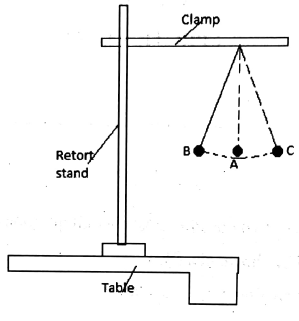
Proceed as follows
- Tie a piece of thread to an iron metal ball to form a pendulum.
- Suspend the pendulum from two clamped pieces of wood.
- Adjust the length L of the pendulum to 140 cm.
- Displace and set the ball to start oscillating through a small angle.
- Record the time t for 10. complete oscillations by using stop watch
- Repeat this experiment for value of L = 120cm, 100cm, 80cm, 60cm and 40cm, and record your data as shown in the table below.
| Length L(cm) | 140 | 120 | 100 | 80 | 60 | 40 |
| Time for 10 oscillations (s) |
|
|
|
|
|
|
| Period time T(s) |
| |
|
|
|
|
| T2(s2) |
|
|
|
|
|
|
Questions
- Complete the table above.
- Plot the graph of L against T2
- Find the slope from the graph..
- Use the answer you obtain in (iii) above to find the value of g given that
![]()
- Give the physical meaning of g.
- Mention two effects of g.
2. The aim of this experiment is to determine the E.m.f and internal resistance of the cell. You are provided with 2 dry cells an ammeter (0 — 3) A, a resistance box, a switch and connecting wires
Procedure.
a. Connect the wire as shown in figure 2. Below, Put R = ln and quickly read the value of Ion the ammeter.
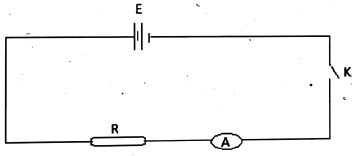
b. Repeat the procedure s in (a) above for the value of R = 2Ω, 3Ω, 4Ω and 5Ω respectively.
c. Tabulate your results in a suitable table include the value of 1/L
d. Plot the graph of R against 1/L
e. Calculate the slope of the graph
f. Evaluate the E and r for one cell, given that ![]()
g. Suggest the three possible sources of error and how they can be minimized.
LEARNINGHUBTZ.CO.TZFORM FOUR PHYSICS_PRACTICAL EXAM SERIES 159
PRESIDENT’S OFFICE REGIONAL ADMINISTRATION AND LOCAL GOVERNMENT
FORM FOUR PRACTICAL EXAMINATION
031/2A PHYSICS 2A
(ACTUAL PRACTICAL)
(For Both School and Private Candidates)
Time: 2:30 Hours September 2022 .
Instructions
- This paper consists of two (2) questions.
- Answer BOTH questions.
- Cellular phones and any unauthorized materials are not allowed in the examination room.
- Where calculations are involved show your work systematically.
- Mathematical tables and non-programmable calculators may be used.
- Write Your Examination Number on every page of your answer booklet(s).
- Use acceleration due to gravity = 10m/s2.
- Use π= 3.14
1. You are provided with a metre rule, knife edge, two strings of length 100cm each and two weights W1 and W2 of masses 50g and 100g respectively and proceed as follows:
(a) Balance a metre rule on a knife edge, put a mark and write G at the balancing point using a piece of chalk or pencil. Measure and record the length L, with its width W and thickness t of the metre rule using a vernier caliper.
(b) Place the metre rule on a knife edge so that the knife edge is at 60cm of your metre rule (see figure 1(a)). Suspend weight W2 of 100g on the right hand side of the knife-edge.
Adjust W2 until the metre rule balances horizontally.
Read and record length b and c as seen in the figure 1(a).
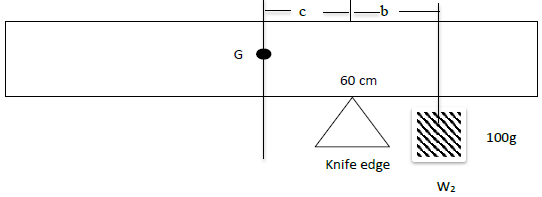
(i) Suspend weight W1 of 50g on the left hand side of the knife edge at the position of 47cm and adjust weight W2 until the metre rule balances horizontally as seen in figure 1 (b).
Read and record the lengths “a” and “b”.
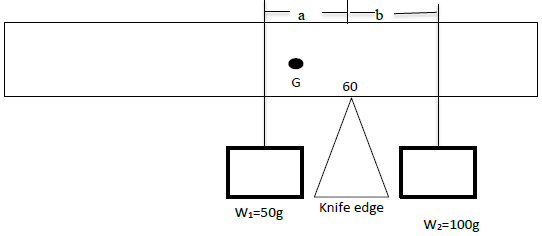
(c) Repeat procedures in by adjusting the position of W1 to the left at the interval of 3cm to obtain other four (4) readings.
Table of results:
| a(cm) | b(cm) |
(d) Plot the graph of “b” against “a”.
(e) What is the nature of the graph?
(f) Calculate the slope (s) of the graph.
(g) (i) Read b – intercept given that
![]()
(ii) What does
![]()
represent in your graph?
(iii) Calculate the value of W using the relation
![]()
What does W represent?
(h) (i) Find the value of the ratio
![]()
Note: The mass of m of a metre rule can be obtained by calculations.
(ii) What is the physical meaning of the value of p?
(i) State the possible sources of error in the experiment.
(j) How can you minimize error in 1(i)?
(k) State the aim of experiment.
2. You are provided with two plane mirrors, an optical pin, a sheet of plane, drawing paper, mirror holder or office pins, a protractor, a ruler and a drawing table. Proceed as follows:
(a) Draw two lines at right angles
(b) Place the two plane mirrors along the top two lines using the mirror holder or office pins as shown in figure 3.
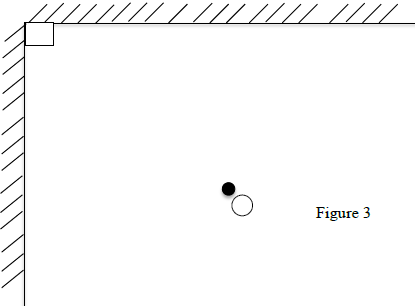
(c) Put an optical pin, at O when θ= 90o look onto one of the mirror and count the number of images, n, you see.
(d) Repeat procedures in 2(c) for θ = 72o, θ = 60o, θ=45o and θ=30o.360o
(e) Tabulate your results for the values of θ, n and 360o/θ
(f) Plot a graph of number of images n, against 360o/θ
(g) From the graph
(i) Determine the slope
(ii) Find the number of images if 360o/n =9
(iii) Find the value of y-intercept.
(iv) Derive the equation relating the number of images and 360o/θ
(h) From your Experiment
(i) What happens to the number of images as the value of angle ? is reduced?
(ii) What happens to the number of images, when θ = 0o?
(i) State a possible source of errors and how you can minimize it.
(j) What is the aim of this experiment?
LEARNINGHUBTZ.CO.TZFORM FOUR PHYSICS_PRACTICAL EXAM SERIES 126
PRESIDENT’S OFFICE REGIONAL ADMINISTRATION AND LOCAL GOVERNMENT
FORM IV PRACTICAL EXAMINATION
PHYSICS 2A (ACTUAL PRACTICAL)
24 HOURS ADVANCED INSTRUCTION
1. IMPORTANT
1.1 Great care must be given not to divulge the instructions to both candidate and unauthorized person either directly or indirectly
1.2 Note that you will not be allowed to open the envelope containing the question paper before commencement of the examination
2.0 Preparation and labeling of chemicals
Question 1
- retort stand with its accessories
- metre rule
- scale pan
- Stop watch
- Masses of 50g, 100g, 200g
- Spring which can extend 6cm by 50g mass
Question 2
- 8 connecting wires
- 2 dry cell (ABC super electric size D, 1.5V)
- Voltmeter (0-2V)
- Ammeter (0-1A)
- Constant wire SWG 28 of 100cm
- Plug key
- Rheostat (0-200ohm)
PRESIDENT’S OFFICE REGIONAL ADMINISTRATION AND LOCAL GOVERNMENT
FORM IV PRACTICAL EXAMINATION
031 / 2A PHYSICS ACTUAL PRACTICAL 2A
TIME: 3 HOURS
Instructions
- This paper consists of total of two (2) questions
- Answer all questions
- Marks for each question thereof indicated
- Non-programmable calculators may be used
- Cellular phones are not allowed in the examination room
- Write your examination number on every page of your answer booklets
- The following constants may be used
Acceleration due to gravity, g = 10m/s2 or 10N/kg
Pie ![]() = 3.14
= 3.14
- The aim of this experiment in figure below is to verify Hooke’s using a spring
Proceed as follows
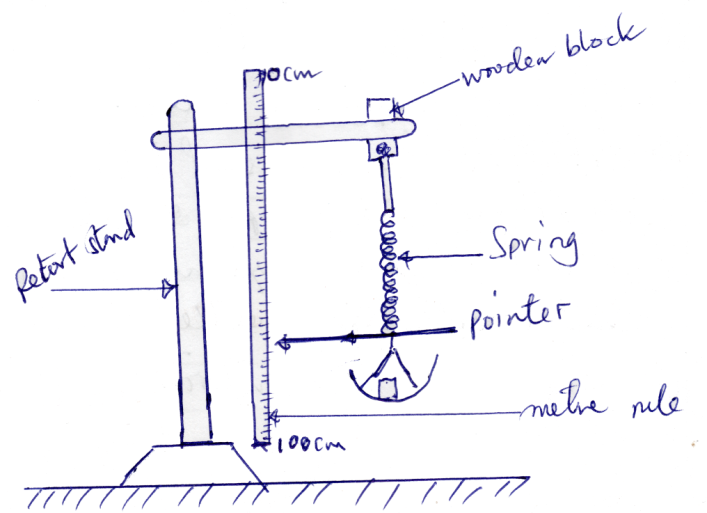
- Set up the apparatus as shown in the figure above
- Record the length Lo indicated by the pointer without mass on the spring
- Place a 50g mass on the spring and record the new length L
- Repeat this procedure for m= 100g, 150g, 200g and 250g each time measure the responding length (L)
- Tabulate your results as follows
Initial length Lo = _____ (1mark)
| Mass (g) | Force (N) | Length (cm) | Extension e=(L-L0)cm |
| 100 |
|
|
|
| 150 |
|
|
|
| 200 |
|
|
|
| 250 |
|
|
|
| 300 |
|
|
|
- Complete the table
- Plot a graph of force (N) against extension e (cm) (7marks)
- What are the values of intercepts? (2marks)
- Determine the slope of the graph (3marks)
- What is the physical meaning of the slope (2marks)
- What are the possible source of errors (2marks)
- State the law which governed the experiment (3 marks)
2. The aim of the experiment is to determine the resistivity of an electrical conductor P

- With P having a length of 50cm, connect up the circuit as shown above, close the key and adjust Rheostat Rh so that the current in Ammeter is 0.2A. record the current I and potential difference between its ends
- Repeat the procedure with correct I = 0.30A, 0.40A, 0.50A and 0.60A.
- Record your results in table below
| Current (I) |
|
|
|
|
|
|
| P.d (v) |
|
|
|
|
|
|
- Plot a graph of V against I and calculate slope G
- Deduce resistivity of the conductor of the wire P given that
Resistivity = ![]() where, d = diameter of wire P and c is the length of the wire P
where, d = diameter of wire P and c is the length of the wire P
LEARNINGHUBTZ.CO.TZFORM FOUR PHYSICS_PRACTICAL EXAM SERIES 111
THE PRESIDENT’S OFFICE MINISTRY OF EDUCATION, REGIONAL ADMINISTRATION AND LOCAL GOVERNMENT
FORM FOUR PRACTICAL EXAMINATION SERIES
PHYSICS 24 HOURS INSTRUCTIONS
CODE NO. 031/2A
Question one (1)
- 1 Spiral spring
- 1 Retort stand with its accessories
- 1 Meter ruler
- 1 Pendulum bob
- 1. Scale pan
- 1 Pointer
- Masses of 20g, 40g,60g, 80g and 100g
- 1 graph paper
Question two (2)
- 1 white sheet of paper
- 1 protector
- 4 optical pins
- 4 thumb pins
- 1 drawing board
- 1 plane mirror
- 1 graph paper
- Transparent ruler
PHYSICS 2A (ACTUAL PRACTICAL A) EXAMINATION
INSTRUCTIONS
- This paper consists of two (2) questions
- Answer all questions
- Whenever calculations are involved show your work Cleary
- Marks for questions are indicated at the end of each question
- Cellular phones are NOT allowed in the examination room
- Calculators may be used whenever necessary
- Write your examination number on every page for your answer booklet(s)
- If necessary use g = 10m/s2
1. You are provided with the following apparatus: meter rule, Weights of different masses, object p, spiral spring, pointer, pan and retort stand with clamp. Assemble the given apparatus as shown in figure 1 below.
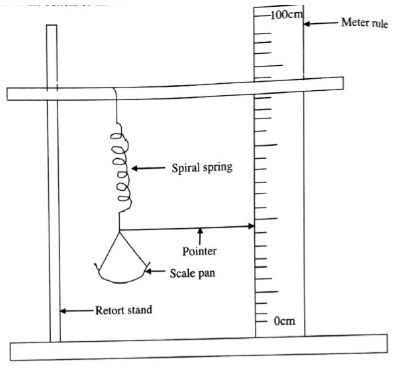 Figure 1 |
Procedures
- Record the pointer reading on the scale of meter rule when the pan is empty as LO
- Put 20g to the pan and record pointer reading as L
- Find extension, e = LO – L
- Repeat the procedures for masses of 40g, 60g, 80g and 100g
- Put object P on a pan and record its extension
- Summarize your results as follows
LO =
| Mass (g) | 20 | 40 | 60 | 80 | 100 | P |
| Weight (N) |
|
|
|
|
| X |
| Pointer reading(cm) |
|
|
|
|
|
|
| Extension, e = LO – L (cm) |
|
|
|
|
|
|
- Plot a graph of tension, T (weight in N) against extension, e (cm)
- Determine the slop S of your graph
- Give the property experienced by a spiral spring
- Suggest the aim of this experiment
- Identify and state the law governing this experiment
- What is the physical meaning of the slop obtained in 1 (h) above
- Use your graph to find the value of P and X given in table 1 above
- State two sources of errors and suggest their control measures (25 marks)
2. The aim of this experiment is to find the relationship between the angle of rotation of reflected ray from the plane mirror and the angle of the mirror.
You are provided with a white sheet of paper, drawing board, plane mirror with holders, transparent ruler, protractor, optical pins and thumb pins. Proceed as follows:
- Put the drawing paper on the drawing board using thumb pins and draw two straight lines AB and CD to enclose an angle of α =l0°. Draw the line through 0 making 75° with AB. Then insert two optical pins P and Q on this line as shown in Figure.2.
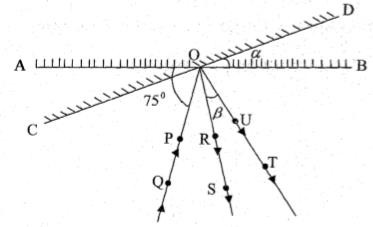 Figure 2 |
- Place the reflecting surface of the mirror along AB. Place other optical pins R and S to appear in straight line with images of P and Q. Remove the pins R and S and join the line ORS.
- Turn the mirror through an angle α = 10° so that its reflecting surface lies along CD. Stick pins T and U to appear in line with the images of P and Q. Join the line OUT. Record the angle β° formed by RS and UT.
- Repeat the experiment for α =l5°, 20°, 25° and 30° on the separate paper for each case
- Tabulate your results.
- Plot a graph of β° against α°
- Determine the slope of your graph.
- Find the reciprocal of the slope.
- From your graph, deduce the relationship between β° and α°
- Describe the significance of the slope obtained in 2 (g)
- Suggest any two sources of errors and their precautions.
Note: Attach your diagrams with the answer booklet. (25marks)
LEARNINGHUBTZ.CO.TZFORM FOUR PHYSICS_PRACTICAL EXAM SERIES 104
Hub App
 For Call,Sms&WhatsApp: 255769929722 / 255754805256
For Call,Sms&WhatsApp: 255769929722 / 255754805256
 For Call,Sms&WhatsApp: 255769929722 / 255754805256
For Call,Sms&WhatsApp: 255769929722 / 255754805256









